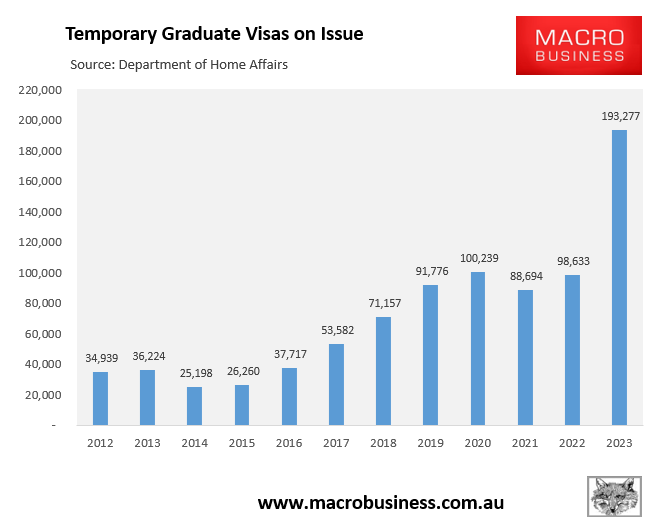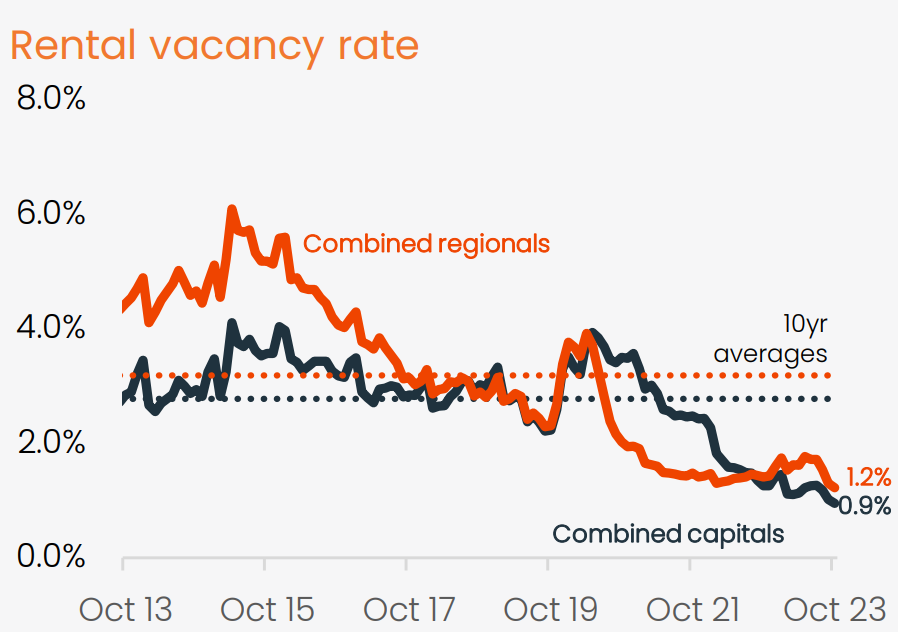Australia is witnessing an unparalleled influx of international students.
The most recent data on temporary visas provided by the Department of Home Affairs revealed that a record 664,200 student visas were on issue in September, representing an annual growth of 306,300:

As you can see above, student visa numbers in September were around 110,000 higher than the September 2019 peak.
Graduate visas are also at an all-time high, with 193,300 on issue in September, up by around 95,000 over the year:

This means that in September, approximately one in every 30 people in Australia held a student or graduate visa—a truly astounding number.
The record surge in international students has played a major role in Australia’s rental crisis, with rental vacancy rates across the combined capital cities having plummeted to a record low 0.9%, along with rampant rental price inflation.

Source: CoreLogic
Given the unprecedented pressures on the nation’s housing market, which is also helping to drive-up inflation and interest rates, there are now calls to cap international student numbers.
As usual, these calls have been met with opposition from lobbyists in the higher education space who warn that capping student numbers would reduce revenues earned by the sector:
“There are only 3% to 4% more international students studying in Australia in 2023 than there were in 2019, many of whom live in purpose-built student accommodation”, said Jake Foster, chief commercial officer with student recruitment firm AECC.
“It took the Australian international education sector years to recover from COVID border closures; we need to be very careful of the messages we send to prospective international students considering Australia”, he said.
Actually Jake, total student visas on issue in September 2023 were 20% above September 2019. And the overwhelming majority of international students do not live in “purpose-built student accommodation”. nice try though.
Rohan Pitchford, an economist with Australian National University, also claimed capping student numbers was “nonsensical”.
“It also ignores the positive impact such students have in supply of labour to employers who are struggling to find workers at the minimum wage. This aspect is anti-inflationary”, he wrote on Twitter (X).
Righto Rohan, so we should ignore the immense pressure on the rental market, which is driving Australians into poverty and homelessness?
Let’s be real here. Australian universities are not-for-profit organisations that currently do not pay tax (unlike other ‘export’ industries). This is despite universities acting like corporatised, profit-maximising corporations with senior leadership groups that get paid exorbitant salaries.
The universities, rather than taxpayers, are therefore ‘clipping the ticket’ and collecting the economic rents from Australia’s immigration system via student fees.
They are privatising the gains from record immigration while the external costs are being pushed onto Australians at large, most notably renters.
Everybody who is not a vested interest can recognise that the federal government should actively lower international student numbers from their current unsustainable levels.
This could be achieved by limiting international students to a maximum percentage of enrolments within both courses and institutions.
Numbers could also be capped by requiring universities to provide on-campus accommodation to international students in proportion to their enrolments.
This policy would relieve pressure on Australia’s private rental market while also ensuring that the costs and benefits to universities and Australians from the international student trade are better aligned.
Other ways to reduce international student numbers could involve:
- Tightening entry requirements, including English-language proficiency and proof of finances.
- Tightening licensing and performance standards for private colleges.
- Penalising poorly performing institutions and closing down ‘ghost colleges’.
- Capping the amount of finder fees and kickbacks that can be paid by institutions to education and migration agents.
- Reducing the generosity of work rights for international students and graduates.
- Charging institutions a levy per international student enrolled to ensure that Australians receive a financial return from the trade, similar to how a sovereign wealth fund collects revenue from mineral exports.
In summary, Australia should aim for a smaller number of higher-quality students.
Unfortunately, the Albanese government took a giant step backwards when it signed two migration pacts with India earlier this year with the explicit aim of boosting the number of Indians studying, living and working in Australia.
These migration pacts will make it more difficult to lower international student numbers to sustainable levels, while also degrading quality.

